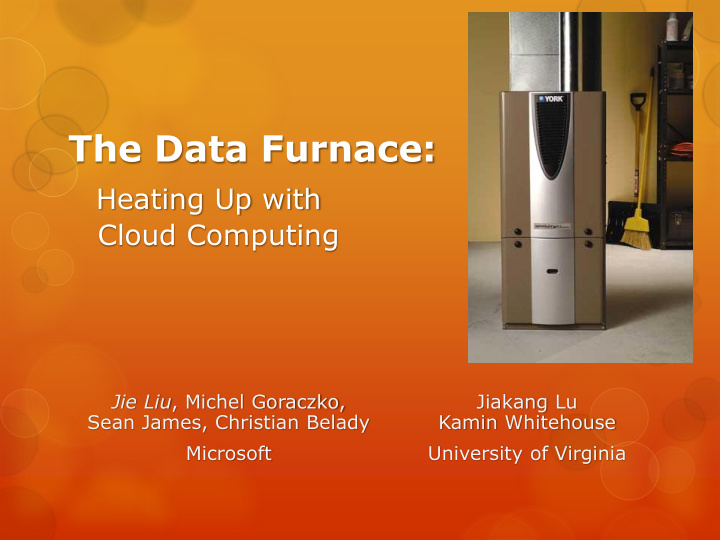



The Data Furnace: Heating Up with Cloud Computing Jie Liu , Michel Goraczko, Jiakang Lu Sean James, Christian Belady Kamin Whitehouse Microsoft University of Virginia
The Cloud Is Big!
The Cloud Is Hot! IT industry Constitutes about 2% of total US energy consumption Consumed 61 Billion kWh in 2006, enough to power 5.8 Million average US households Paid $4.5 Billion power bill in 2006 Is the fastest growing energy consuming industrial sector Will double again by 2011 if continue with the current trend
The Cloud Is Expensive! 50,000 server facility 10% 2% 9% Land Core 19% Electrical 42% 18% Mech Other Architectural Infrastructure Cost Breakdown Data from James Hamilton and Mike Manos
Improving Efficiency REDUCE RENEW REUSE
Home Power Provision 12% provisioned power (30kW)
Home Energy Usage Twice the entire IT! US Energy Information Administration
The Data Furnace Outdoor Temp. DOE EnergyPlus simulator < 70F > 95F 1700 sqft single family house Minneapolis 82% 0.11% 70F set point Pittsburgh 82% 0 5 climate zones DC 77% 0.13% San Francisco 96% 0 Houston 46.5% 0.15% MN 1 min time granularity. Max power required. Assume 300W servers. SFO
Ideal Cost Benefits Amortized cost in conventional DC: $400/server/year Urban electricity price overhead: $0.05/kWh Possible T1 network cost: $2640/year MN PA DC CA TX Provisioned server # 112 114 101 46 37 Current heating exp. 3K 2K 2.5K 1.5K 700 ($/year) Elec. price overhead 9525 6733 5742 3514 1666 heating use ($/year) Elec. price overhead 14.7K 15K 13.3K 6K 4.9K full use ($/year) Current host cost 44.8K 45.6K 40.4K 18.4K 14.8K ($/year)
FAQ#1: Useful? Low-Cost Seasonal Data Centers Opportunistic cycles (SETI) Developing communities hobbyists Low-Bandwidth Neighborhood Data Centers Email serving Ultra-local web services Neighborhood content sharing Delay-tolerance jobs Eco-Friendly Urban Data Centers Small scale cloud computing Content caching Casual collaborations/games
FAQ#2: Hidden Cost? Hardware reliability (Vishwanath et al. SOCC10) 92% servers never need touch 8% servers failed (repeatedly) Average touches per failed server: 3~4/14months Predominantly HDD failures Run a service truck: $100/visit/house Technical Challenges – System Design & Management: Improve reliability by hardware design (low power density, low vibration) Increase replication Fail gracefully
FAQ#3: Residential Power? Home circuit capacity Usage is increasing with electrical cars Consumer power generators are emerging Residential power quality challenges Technical Challenges – Power Management: Close monitoring and control are critical Power availability prediction Power capping and tracking Local energy storage
FAQ#4: Secure? Physical security: Storage and communication security: Computing security: Technical Challenges – Security : Embedded sensors for anti-tampering. Isolation and encryption. Secure execution.
FAQ#5: Performance? Not to replace centralized data centers. The services can be close to end user physically Technical challenges – performance: Networking Placement Elasticity Opportunistic processing
Conclusion Data Furnace Reuse existing power infrastructure Reuse heating energy for computing Be close to end users Other forms of heat reuse: Water pre-heating Apartments/office buildings Agriculture Many, many challenges
Hedging The Cloud
Recommend
More recommend